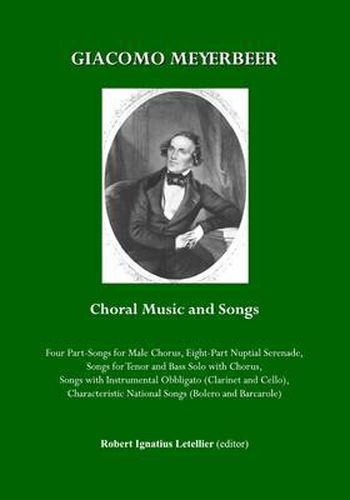Readings Newsletter
Become a Readings Member to make your shopping experience even easier.
Sign in or sign up for free!
You’re not far away from qualifying for FREE standard shipping within Australia
You’ve qualified for FREE standard shipping within Australia
The cart is loading…






This second volume of Meyerbeer’s non-operatic work is devoted to his secular choral writing for male voices, solo songs with chorus, and later songs with instrumental obbligato and local colour.Choral writing-so much part of the operatic tradition, also germane to religious music, and integral to the public music of celebration-is fundamental to the next genre Meyerbeer wrote for, the part-song, a typical German tradition. Meyerbeer’s part-songs for male chorus, most of which were provided for the Liedertafel Friends of the Berlin Singakademie, use the age-old themes of unity, friendship, patriotism, homeland, hunting: Bundeslied (1835), Freundschaft (1842), Dem Vaterlande (1842), and Die lustigen Jagersleut (1842). This set of four illustrates the composer’s harmonic richness, his imaginative use of all the variants of vocal timbre and tessitura, in part-writing, textured unison and homophony.Rather different were two later numbers, Der Wanderer und die Geister an Beethovens Grabe (1845), and Das Lied vom blinden Hessen (1862). The first is a personal tribute to the memory of Beethoven, for bass solo and chorus, that uses the Platonic imagery of the music of the spheres as the transcendent ideal of beauty. The late Song of the Blind Hessian, requiring a tenor soloist and chorus, is a deeply felt lament in which the protagonist’s blindness becomes the metaphor for a series of variations on loneliness, exile and loss, and eventually a correlative of disenfranchisement and yearning for freedom-political and spiritual. In both songs the chorus has a more dramatic role than in the part-songs, reflecting on the situation presented in the soloist’s manifesto, sometimes serene and supporting, at others adding to the sense of anguish and aspiration. Throughout his career Meyerbeer wrote songs. These reflected the circumstances of his life, the various cultural milieux he moved in-particularly, of course, the German, Italian and French worlds. The majority of Meyerbeer’s songs were composed between 1828 and 1860, in tandem with his illustrious operatic career and socially prestigious musical posts in Berlin. Meyerbeer’s songs in whatever genre show the influence of the Lied, especially in his subtle use of the piano parts. Unique among Meyerbeer’s songs are two written with instrumental obbligatos: Hier oben (Des Schafers Lied or Hirtenlied) (Ludwig Rellstab) (1842) (for tenor, clarinet and piano, published in Paris in 1857), and Pres de toi ( Neben Dir ) (Gustav Roger, translated by the poet and historian Joseph Duesberg) (1857) (for tenor with violoncello and piano, published in Paris in the same year). Meyerbeer adapted a strong sense of local colour in two songs composed in the 1850s: the Spanish bolero in the melodie written for the incidental music to Aylic-Langle’s play Murillo (Ballade dans la comedie Murillo, ou Le Peintre mendiant un modele) (Paris, 1853); and the Italian barcarole in the canzonetta A Venezia (Pietro Beltrame) (1856) [Paris: Brandus, 1856; Cologne: Schloss, n.d.].
$9.00 standard shipping within Australia
FREE standard shipping within Australia for orders over $100.00
Express & International shipping calculated at checkout
This second volume of Meyerbeer’s non-operatic work is devoted to his secular choral writing for male voices, solo songs with chorus, and later songs with instrumental obbligato and local colour.Choral writing-so much part of the operatic tradition, also germane to religious music, and integral to the public music of celebration-is fundamental to the next genre Meyerbeer wrote for, the part-song, a typical German tradition. Meyerbeer’s part-songs for male chorus, most of which were provided for the Liedertafel Friends of the Berlin Singakademie, use the age-old themes of unity, friendship, patriotism, homeland, hunting: Bundeslied (1835), Freundschaft (1842), Dem Vaterlande (1842), and Die lustigen Jagersleut (1842). This set of four illustrates the composer’s harmonic richness, his imaginative use of all the variants of vocal timbre and tessitura, in part-writing, textured unison and homophony.Rather different were two later numbers, Der Wanderer und die Geister an Beethovens Grabe (1845), and Das Lied vom blinden Hessen (1862). The first is a personal tribute to the memory of Beethoven, for bass solo and chorus, that uses the Platonic imagery of the music of the spheres as the transcendent ideal of beauty. The late Song of the Blind Hessian, requiring a tenor soloist and chorus, is a deeply felt lament in which the protagonist’s blindness becomes the metaphor for a series of variations on loneliness, exile and loss, and eventually a correlative of disenfranchisement and yearning for freedom-political and spiritual. In both songs the chorus has a more dramatic role than in the part-songs, reflecting on the situation presented in the soloist’s manifesto, sometimes serene and supporting, at others adding to the sense of anguish and aspiration. Throughout his career Meyerbeer wrote songs. These reflected the circumstances of his life, the various cultural milieux he moved in-particularly, of course, the German, Italian and French worlds. The majority of Meyerbeer’s songs were composed between 1828 and 1860, in tandem with his illustrious operatic career and socially prestigious musical posts in Berlin. Meyerbeer’s songs in whatever genre show the influence of the Lied, especially in his subtle use of the piano parts. Unique among Meyerbeer’s songs are two written with instrumental obbligatos: Hier oben (Des Schafers Lied or Hirtenlied) (Ludwig Rellstab) (1842) (for tenor, clarinet and piano, published in Paris in 1857), and Pres de toi ( Neben Dir ) (Gustav Roger, translated by the poet and historian Joseph Duesberg) (1857) (for tenor with violoncello and piano, published in Paris in the same year). Meyerbeer adapted a strong sense of local colour in two songs composed in the 1850s: the Spanish bolero in the melodie written for the incidental music to Aylic-Langle’s play Murillo (Ballade dans la comedie Murillo, ou Le Peintre mendiant un modele) (Paris, 1853); and the Italian barcarole in the canzonetta A Venezia (Pietro Beltrame) (1856) [Paris: Brandus, 1856; Cologne: Schloss, n.d.].